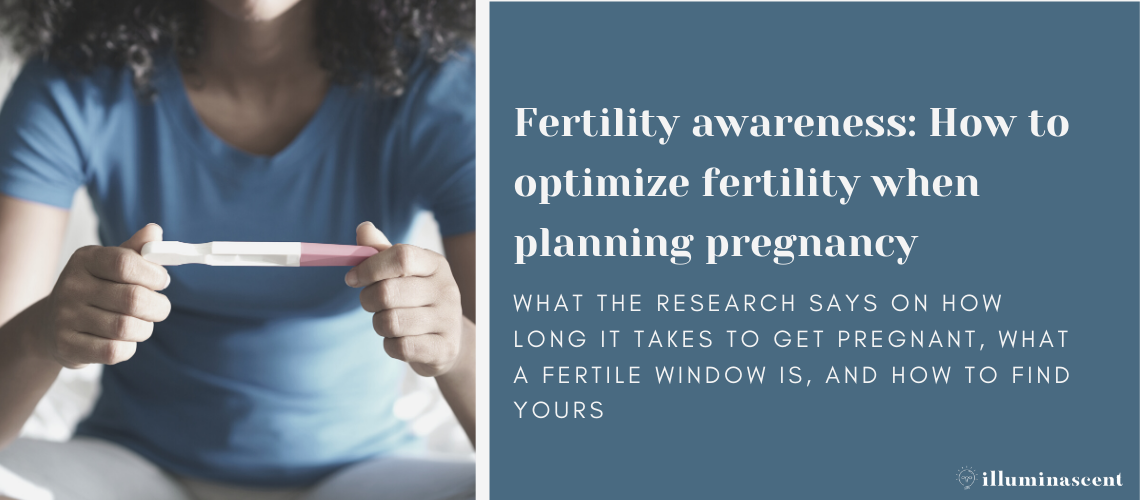How long does it take to get pregnant?
Before answering this question, it’s important to note that there are many factors that can impact fertility (in both females and males).
Factors that may decrease fertility:
- Age (primarily female1, also male2)
- Tobacco use (female/male)3
- Impact reduced within year of quitting4-7
- Being obese (female/male)8,9 or underweight (female)10
- Vigorous/intense physical activity in those underweight (BMI < 25 kg/m2, female)11
- 4 hours or more of strenuous exercise weekly over years is linked to less success for those undergoing IVF12
- Exercise slightly increases fertility in those who are overweight/obese11
So, now that we know that, how long does it take to get pregnant?
A 2003 study looked at 346 women using ‘Natural Family Planning’ (NFP) methods to conceive from their first cycle onwards (don’t worry, we’ll talk all about NFP below). Participants were followed for a maximum of 29 cycles (so about 2.5 years).13
The study found:
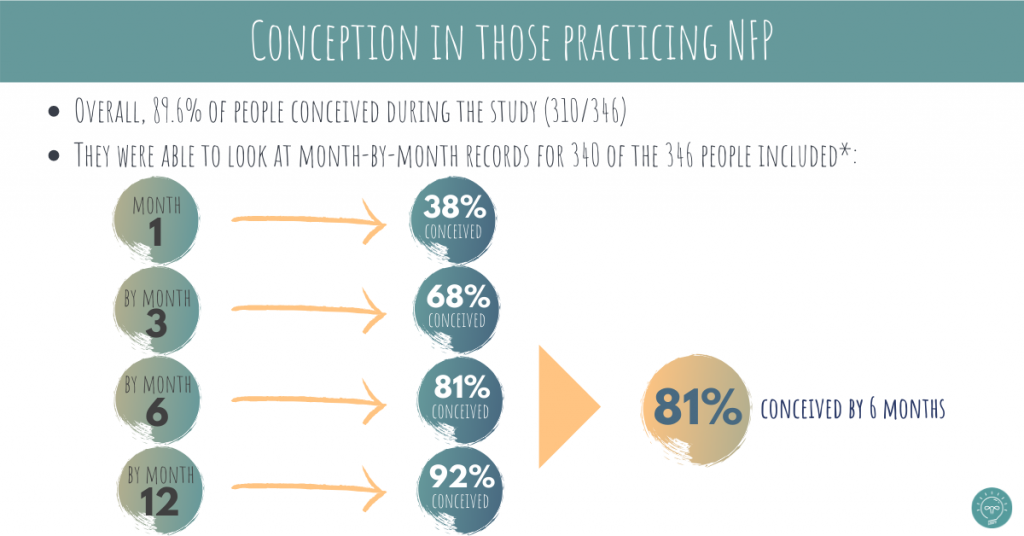
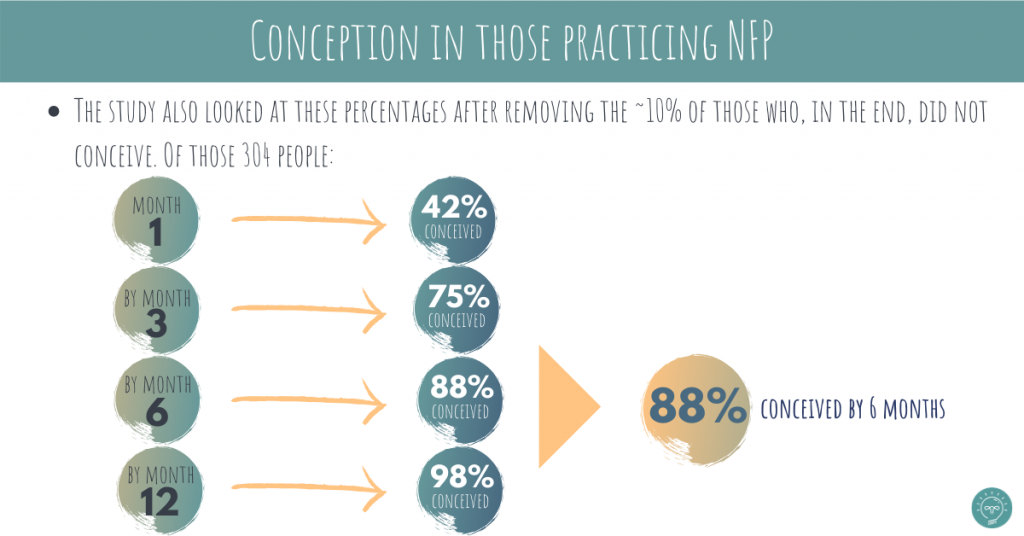
I do want to point out a few important things here:
- Average age of women in the study was 29.0 years (ranging from 20 to 44) and for men it was 31.6 years
- There was no difference in the age of women who conceived vs. those who didn’t, but there was for men (the average age of men who didn’t conceive was higher)
- Average age of women having their first child continues to increase and as of 2014 was 26.314 in the USA and 29.6 in Canada15, so the average age in this study is on par with the timing for first pregnancies in North America
- About half of those who eventually got pregnant and 31% of those who didn’t had a previous pregnancy
- Those who didn’t ovulate for 3 or more cycles were excluded from the study
- All were practicing Natural Family Planning in order to time intercourse optimally to get pregnant
- There was no difference in the age of women who conceived vs. those who didn’t, but there was for men (the average age of men who didn’t conceive was higher)
All of this is to say – this was a relatively young, reproductively ‘healthy’ group (all were ovulating) who used tools to optimally time intercourse to successfully get pregnant. These aren’t minor points and they’re important to keep in mind.
What happens after that one-year mark?
- Professional bodies in Canada and the USA define infertility as a lack of conception after having unprotected sex for:16,17
- 1 year in those 35 and under
- 6 months in those 36 and over
- They suggest a fertility evaluation once those milestones are reached (and if you’re over 40 – you can talk to you OB-GYN now)
What is natural family planning?
Now that we know how long it takes to get pregnant in those practicing natural family planning, what exactly is natural family planning?
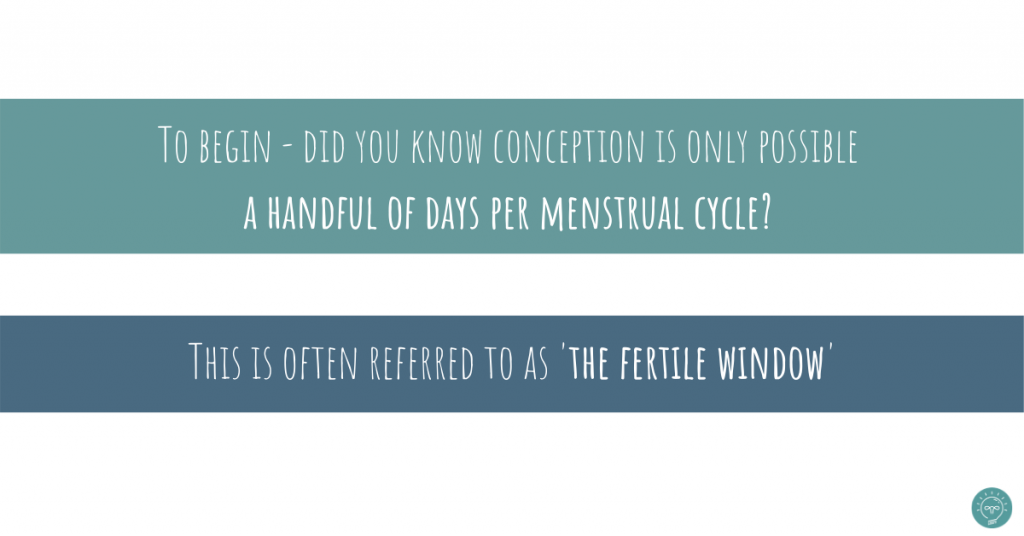

- Natural family planning is about identifying that fertile window and having sex, or not having sex (or using protection), accordingly, depending on your goals.
- Is knowing your fertile window essential to get pregnant? No! People ‘go with the flow’ all the time and successfully get pregnant and feel best with that method. Some are amazing at tracking and don’t get pregnant. There’s not a black and white answer here. But research says tracking can definitely help
A 2019 North American study looked at 5688 people trying to get pregnant. On average, they were 29.9 years old and had spent about 2 cycles trying to get pregnant. One third had never been pregnant before.18

In 2017 (warning: this study blows my mind) researchers followed 187 people for 8 months who were trying to get pregnant.19
- They were 21 to 47 years old and on average had been trying to get pregnant for 3.5 years (ranging from 1 year to 8 years). That’s a really long time.
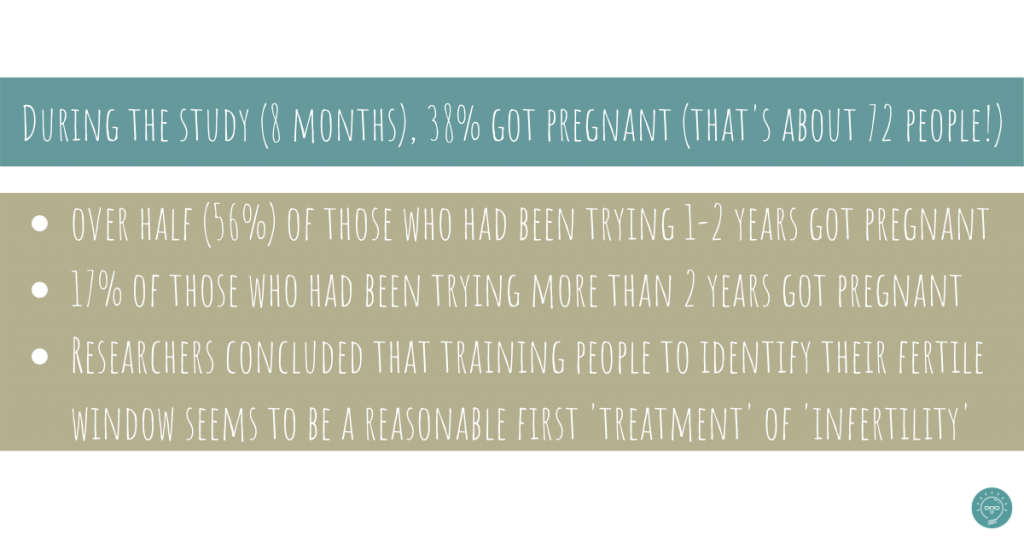
So, when during your cycle is this fertile window exactly?
The chances of pregnancy if you have unprotected sex on the following days during your menstrual cycle is:20
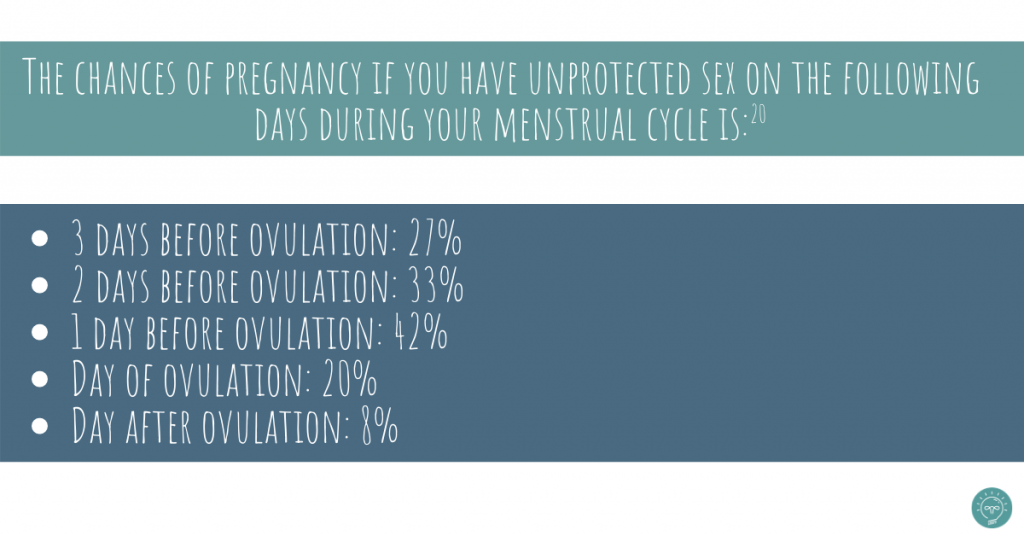
In general, the fertile window is considered to be approximately 6 days – the 5 days before ovulation plus the day of ovulation.21
- This accounts for the fact that sperm can typically survive for 3 – 5 days in the genital tract and that the egg needs to be fertilized in the 12 – 24 hours after release
- That said, it can vary between individuals – one study used ultrasound to confirm fertile window and found it to range from 1 to 5 days or more22
But how do you identify when you’re ovulating and what your fertile window is?
In ~90% of cycles, ovulation occurs in the four days before or after the midpoint of the cycle. In 30% of cases ovulation occurs at the exact midpoint (i.e. day 14 of 28 days, or day 15 of 30 days).23

There are many methods that can be used to determine ovulation. We’ll discuss them briefly here.
- Menstrual cycle charting
- Simplest and least expensive
- Involves tracking first and last day of period for several months in a row
- Cycles outside the range of 25 to 35 days may indicate ovulation is not happening (though being in that range doesn’t guarantee ovulation either)
- You should also note symptoms that may indicate ovulation, as well as premenstrual symptoms. For example:
- Increase in thin cervical mucus secretions around mid-cycle
- Cramps, breast tenderness, fluid retention, mood changes
- Basal body temperature monitoring
- Your basal body temperature (BBT) increases about 0.5°C/F after ovulation
- Daily monitoring of your temperature upon waking, while still in bed, at the same time daily can allow you to identify a rise in temperature, and therefore help you identify if and when you’re ovulating
- BBT drops again before your period begins, or stays elevated in cases of pregnancy
- Measurement of luteinizing hormone (LH)
- It is a rise in LH that triggers ovulation, so measuring LH in urine, for example (via ‘ovulation predictor kits’), is one way to detect when ovulation is about to occur
- Tracking your LH surge enables you to identify ovulation before it happens, unlike the above methods. That said, tracking your cycle and BBT enables you to get a picture of your cycle and should help pinpoint when an ovulation test kit would work best (i.e. when exactly should you pee on those sticks?)
- This is also an especially helpful tool for those who have irregular cycles and can’t count on one cycle looking like the last
- Tracking cervical secretions
- Cervical secretions change throughout a menstrual cycle because of changing hormones
- As ovulation nears, the developing follicle (the part that develops and releases an egg each cycle) produces estrogen, which causes the production of cervical secretions
- These secretions are meant to help the sperm through the cervix and help it mature (‘capacitation’) so that it can fertilize the egg
- You can track changes in your cervical secretions or ‘mucus’ (who likes that word, though?) to identify when ovulation is about to occur.
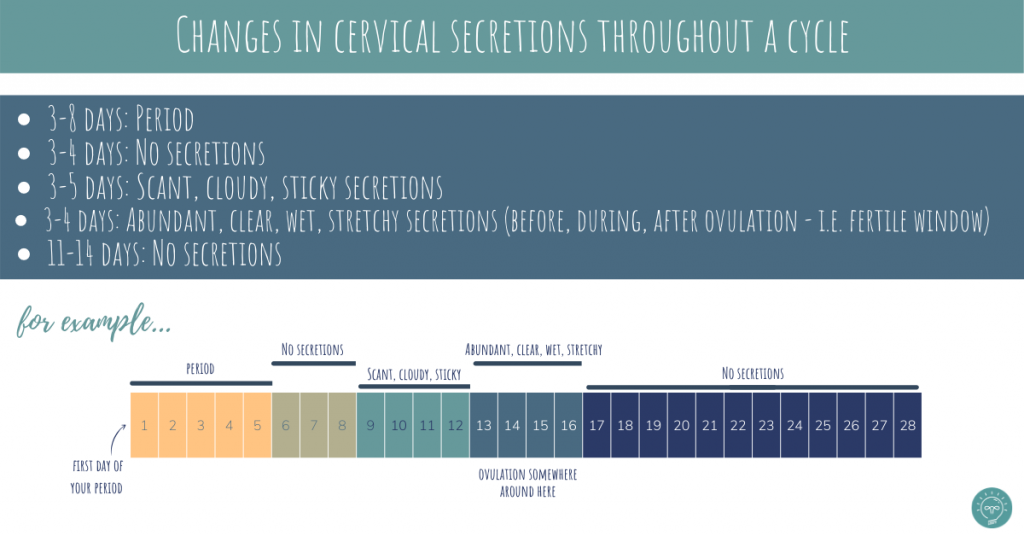
- Tracking cervical position
- The same hormone changes that cause changes in cervical secretions also change the position of the cervix
- Your cervix isn’t the most easily accessible body part, as anyone who has had a pap smear knows. That said, with practice, you can safely learn how to identify and feel your cervix.
- That said, you may have trouble with this if you have a long vaginal canal, or as you approach ovulation when your cervix is higher than usual (more on this below)
- During most of your cycle your cervix is low, closed, firm, and lying against the vaginal wall, the ‘infertile position’.
- Around and during ovulation it is high, open, soft, and straight, which allows sperm to enter (this is when it may be harder to detect)24
- Some say during your infertile window your cervix feels like the tip of your nose, while it feels more like your lips when fertile
Using one or more of the above methods are all valid ways of tracking your cycle and identifying your fertile window to maximize your chances of conception.
What’s the take-home message?
- About 80% or more of people who ovulate and track their cycles to identify their fertile window will get pregnant in about 6 months, with about 90% or more conceiving by the 1-year mark
- That said, many factors such as increasing age and other lifestyle factors can decrease fertility
- There are only a handful of days each cycle that conception is possible
- There are various methods to track cycles and identify your fertile window, and using one or more of these has been shown to decrease the time to conception
- Success using these methods in those trying to conceive for 1 year or more suggests fertility awareness may even be beneficial for this population
References: 1. ACOG Committee on Gynecologic Practice, et al. 2014; 2. Dunson DB, et al. 2004; 3. Practice Committee of the ASRM, 2012; 4. Howe G, et al. 1985; 5. Hughes EG, et al. 2000; 6. Hughes EG, et al. 1996; 7. Curtis KM, et al. 1997; 8. Brewer CJ, et al. 2010; 9. Ma J, et al. 2019; 10. Bates GW, et al. 1982; 11. Wise LA, et al. 2012; 12. Morris SN, et al. 2006; 13. Gnoth C, et al. 2013; 14. Mathews TJ, et al. 2016; 15. Reproductive Health Working Group. 2006; 16. SOGC, 2020; 17. ACOG, 2020; 18. Stanford JB, et al. 2019; 19. Frank-Herrmann P, et al. 2017; 20. Faust L, et al. 2019; 21. Dunson DB, et al. 1999; 22. Keulers MJ, et al. 2007; 23. World Health Organization, 1981; 24. Parenteau-Carreau S, et al. 1988
